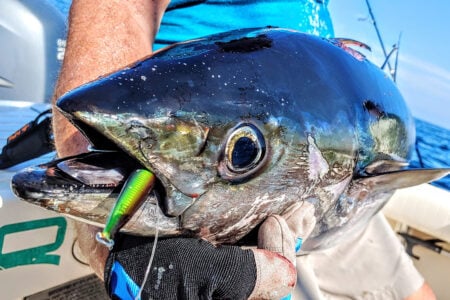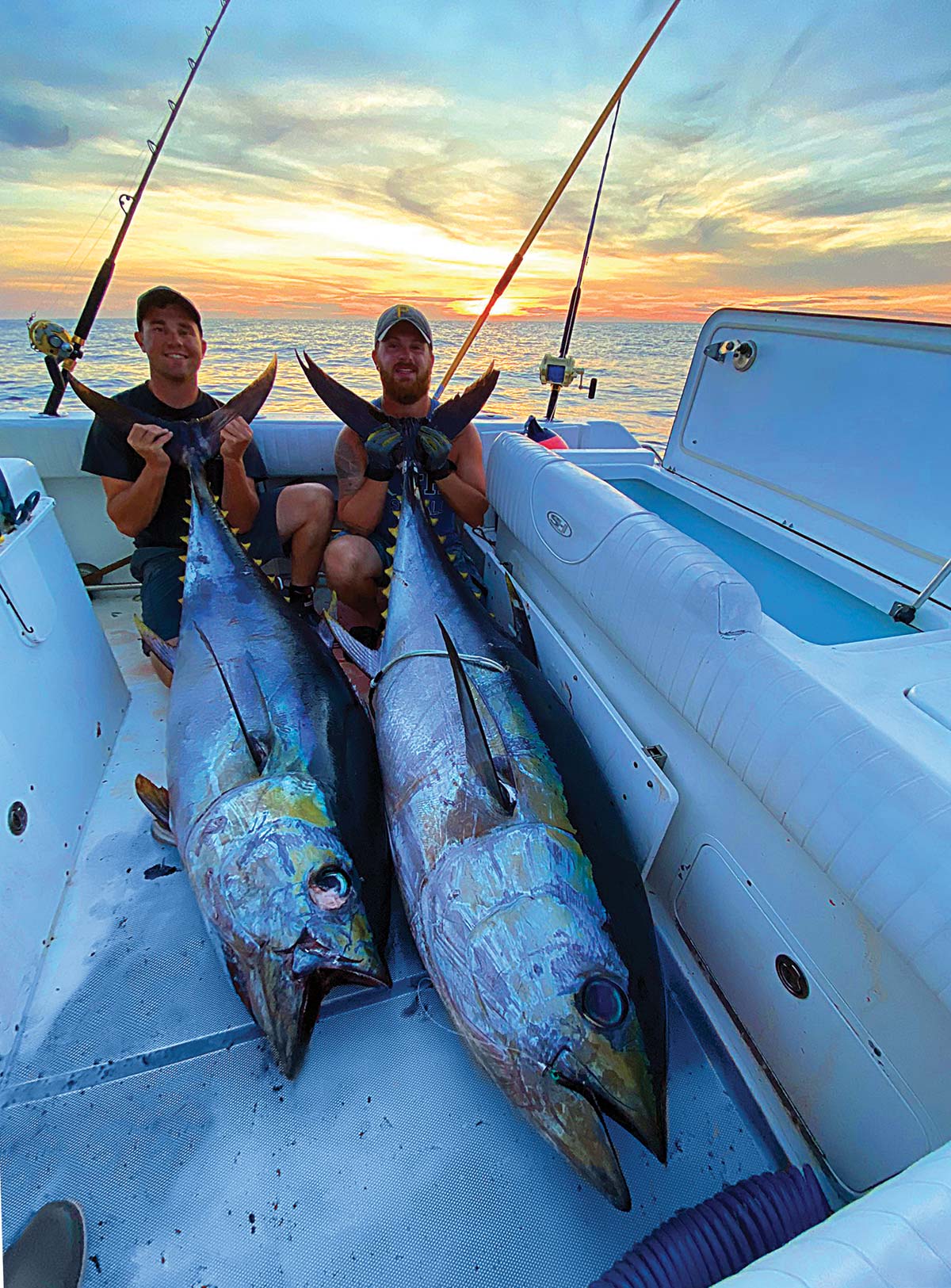
One hundred miles from home and tied into 294 pounds of angry bigeye.
On the morning of August 16, 2021, the 29-foot Sea Hunt center console known as F/V Stormy D departed from Branford, CT en route to Montauk Harbor. Onboard were myself, (25-year-old Capt. Chris Anderson) 21-year-old Capt. Rob Gillis, along with crew members Dan, and Ed Gillis. After stopping for fuel, ice, and a few flats of butterfish, we set a course for West Atlantis with one thing on our minds: bigeye tuna. Yellowfin, albacore, and mahi mahi are all exciting fish to catch and most fishermen would be elated with a fish box full of these bluewater species. However, we were on a different mission, determined to find that wolf pack of jumbo bigeyes.
We pulled up the latest sea surface temperature image as we rounded Montauk and were excited to see a 3-degree temperature break we had been monitoring had finally made it to the east wall of the canyon and was moving quickly west. We arrived just a few miles short of the edge around 5 p.m., set out our spread, and began covering ground. We always begin trolling 5 to 10 miles north of the tip of the canyon not only to conserve fuel but there are often yellowfin and mahi there that make for a good warmup.
The Spread
On a small center console, presentation is everything. During the day, bigeye typically cruise the canyon walls at depths between 200 and 1,000 feet, occasionally coming to the surface to feed. To lure these beasts up from those depths, we use a nine rod spread consisting mostly of our personal favorite, Chatter Lures. We do our best to mirror the spread on both sides of the boat. This creates a more inviting spread allowing multiple tuna in a school to find a lure to eat. In the far outrigger position, 19-inch Chatter Lures side-trackers, either green or pink, run through undisturbed water with ease. For boats with outboards, these side trackers are game changers! As they track out into clean water beyond the boat’s wake, they create the illusion of a larger bait school that is more appealing to large tuna, especially big eye.
From the gunwale we also use Chatter Lures larger 36-inch side-trackers in lemon lime or sand eel color. This allows for a total four bars in our spread with no interference with our other lures. Down the middle of our spread, we run a single bird teaser rigged with a 12-inch weighted green machine. This lure always seems to entice yellowfin and albacore when they are around.
Off the transom corners we run two Nomad DTX-220 Minnows. These subsurface lures are a must-have when working the walls of the Northeast canyons. For any angler doubting these lures I urge you to make sure you are running it properly, we had trouble finding its “sweet spot” in the spread and it wasn’t until we tested it. In order to ensure you are getting this lure to the proper depth, go to an area with a sandy bottom at about 40 to 50 feet deep, get up to trolling speed and begin to let the lure out. Only when you begin dragging bottom will you truly know how much line to let out to get them to troll at that depth, take note and use wisely. Our personal favorite color is the hot pink mackerel.
Last but not least are the Chatter Lures Joe Shute pin rigged ballyhoo lures. Never leave the dock without your ballyhoo! Opinions vary how to run ballyhoo in a Canyon spread. Some captains like them way back from the far outrigger position while others like them close to the transom. We have found the most success from the inner position on our outriggers. This allows us to deploy the ballyhoo 20 to 30 feet behind our 36-inch side trackers which creates the illusion of the ballyhoo falling behind the side tracker, further enticing larger fish to come to the surface and feed. Our go-to colors are red and white during the day and black and purple as we troll through the night. This is precisely the spread we had when hooked into our fish of a lifetime.
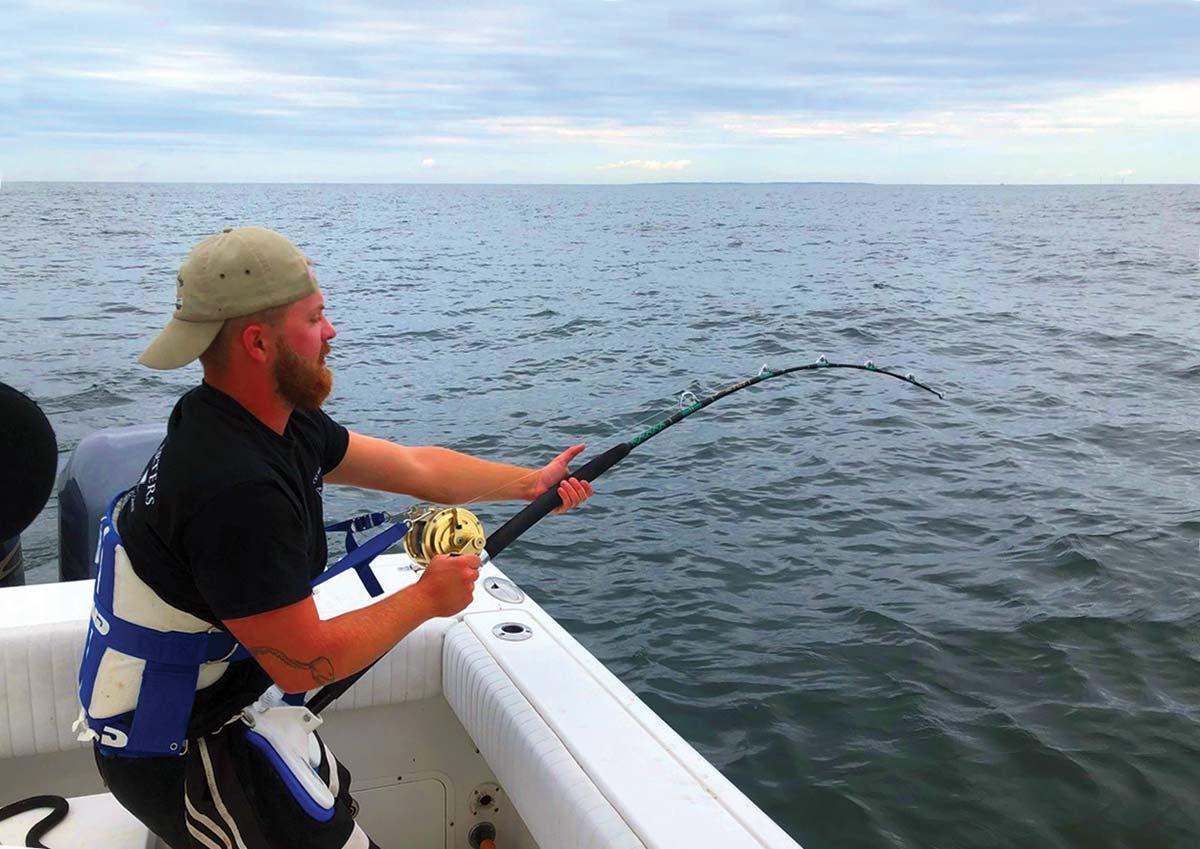
West Atlantis
When we arrived, a few boats were tight on what seemed to be bigeyes, so hopes were high. We worked the area for an hour or two with no bites, and we weren’t marking any fish or bait so we proceeded onward to work down the west wall. As the sun began to set we changed up our spread by switching over to darker lures, purple, black etc. and trolled well into the night. Around 11 p.m. we decided to set up for the night and pulled in the spread. Dan began chunking up butterfish until his hands hurt, Capt. Rob and I prepared our sword baits.
After picking the starting point for our first drift, we began a steady stream of butterfish chunks and set out our baits, two rods rigged and dropped for a gladiator of the deep, which might also be eaten a bigeye, and one chunk bait for a tuna set precisely at the right depth to be in our stream of butterfish chunks. The waiting game was on. We marked a few fish throughout the drift but it wasn’t until around 2 a.m. that we had our first customer. The chunk bait got slammed and the fish made a screaming 30-second run, and about as fast as we had the fish on, it was off. The circle hook pulled, and we were back to square one. The rest of the night was uneventful; the sun began to rise and we were 0 for 1.
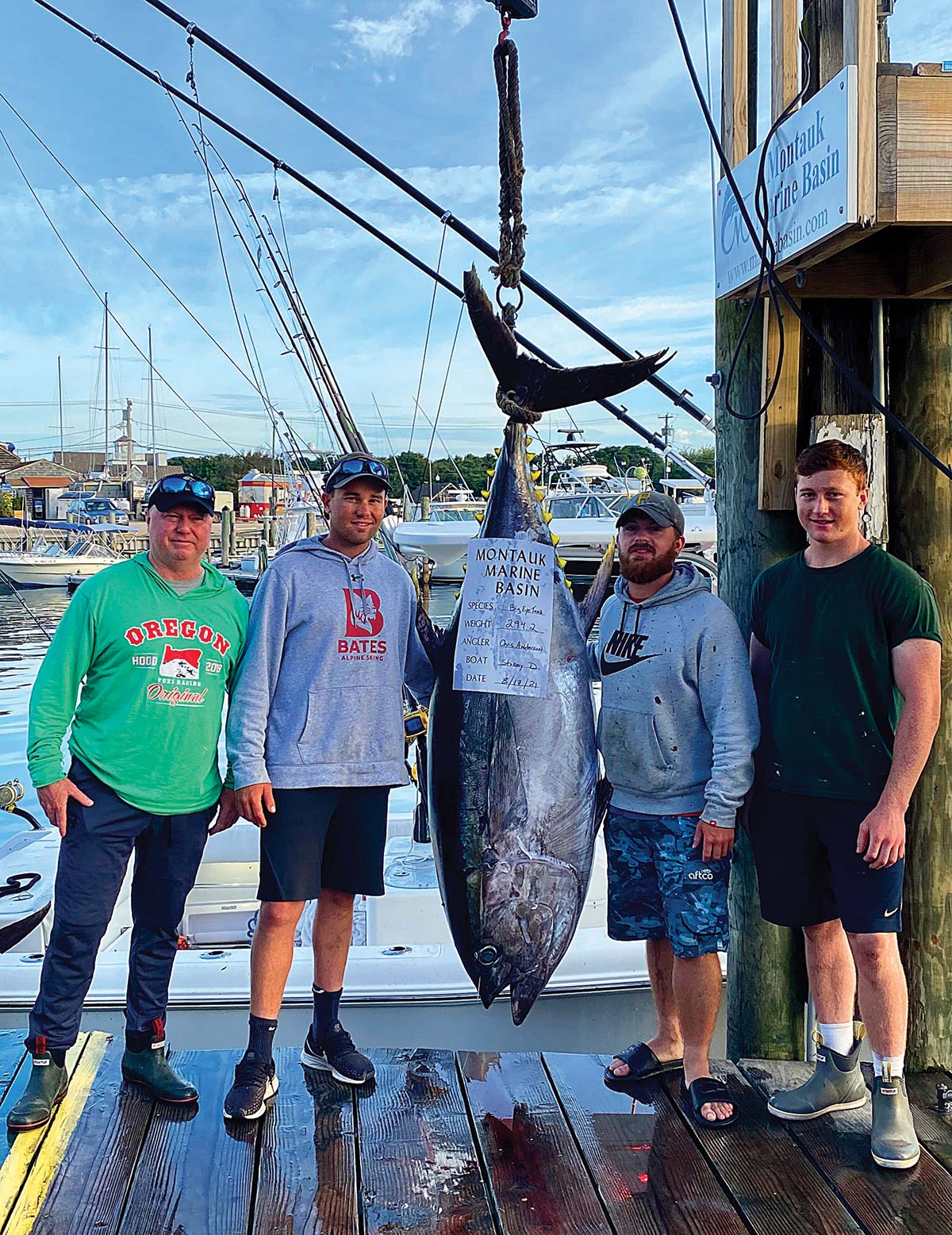
The Wolf Pack
With the sun up, we were back on the troll. It wasn’t long before we started to see some action. We caught a couple decent albacore, around 40 pounds. After trolling the west wall of the canyon with the fleet of other sportfishing boats also not catching for most of the morning we decided to make a move and find some new water all to ourselves. We observed our sea surface temperature charts and pointed to the tip of the canyon, set out fresh ballyhoo, and checked our spread for weeds. This move would prove to be the right one because at around 2 p.m. we got what we came for.
Suddenly, we began marking what we thought was the wolf pack we came for. Our sonar showed a series of marks at around 600 feet and it was determined that working this area in a tight fashion was necessary to raise them up to the surface. Moments later violent splashes erupted all around our spread. Both side trackers got blown up by fish but they didn’t stick, both ballyhoos got violently smashed and only one of them hooked up, but immediately after missing the ballyhoo on the starboard side, a fish came back for our Nomad DTX Minnow and we were tight on two big fish.
Watching 200- to 300-pound tuna blow up on your entire spread is something I hope every fisherman gets to experience because it is – hands down – the most exciting thing you can dream of when out there fishing the deep.
After clearing our lines we prepared to battle these two giant fish. Normally I’d stay on the wheel and keep the boat in position throughout the battle, but something told me to pick up the port side ballyhoo rod which at this point had 500 yards of line dumped in a matter of minutes. With Ed Gillis on the wheel, and Dan setting up the harpoon, Capt. Rob and I were in for a wild ride. It was determined that Rob’s fish was most likely smaller, so our focus shifted to landing his first. After about two hours we had Rob’s fish gaffed and tail roped. This fish measured out to 70 inches and was estimated to weigh about 230 pounds.
Anyone who fishes on a center console knows that the endgame on a big fish is challenging, let alone with another one on the line. Ed kept the boat in perfect position and Dan hit a perfect gaff shot to seal the deal. We could not have been happier that we landed this fish, it was caught on a Nomad DTX 220 minnow.
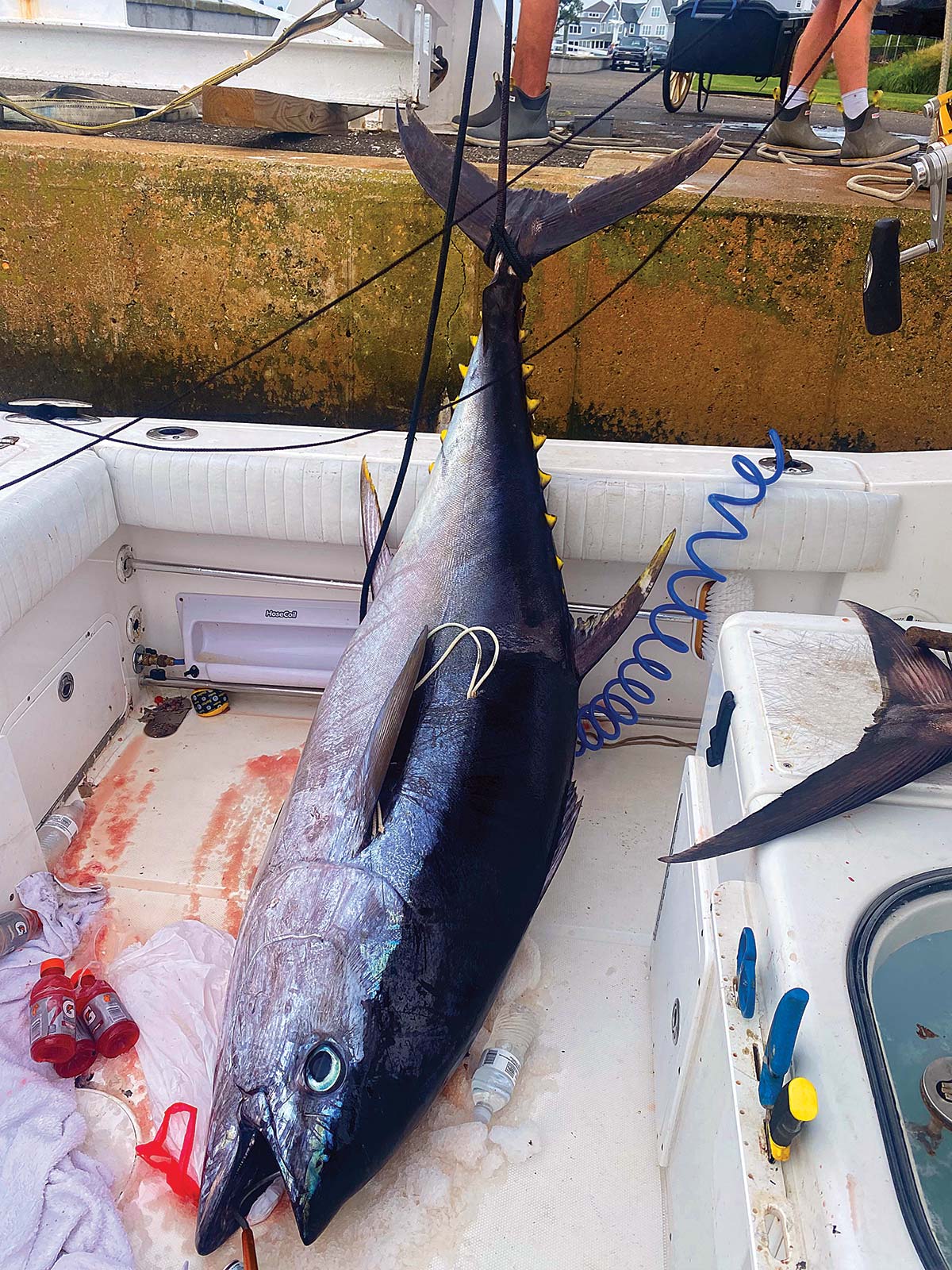
The Battle Of A Lifetime
With the first bigeye tail roped and tied off, it was time to put the heat on this beast of a fish that would not budge. I would gain 50 feet, then lose 80, this fish was truly something special and we all knew it. After about three hours of fighting stand up on a PENN 50W, I began to tire and Capt. Rob asked me if I wanted to pass the rod. I thought for a moment, and said no way. This fish could be a record fish and I was going to get it to the boat if it was the last thing I did. After a red bull and a snickers bar I began to get some steam back.
At one point during the fight I actually thought that maybe the fish had died on the line, we were in a stalemate and I couldn’t gain any ground whatsoever, it felt like dead weight on the end of the line. Well that would prove to be incorrect, because not 30 seconds after making that statement the fish proceeded to dump 200 yards of line. After this run the line went slack and I began to crank as fast as humanly possible and we all thought the worst, I just could not catch up to this fish. So in order to regain tension on the line, Ed gave the boat some throttle and eventually we came tight again, to everyone’s relief the fish was still hooked and had just been swimming at the boat.
Our reels are spooled with about 600 yards of braid with a 200-yard mono topshot, and it wasn’t until the fourth hour that I finally got mono back on the reel. The end was nearing and the sun was beginning to set. Finally we could see something on the fishfinder, a giant mark under the boat sitting at about 90 feet. It stayed this way for what felt like an eternity, up to 50 feet, back to 90 feet, over and over again. It was time to buckle down, I gave it everything I had to get this fish to come up, and finally we had deep color.
Every circle the fish would make I’d gain some line until finally we got a good look at the giant. Capt. Rob and I looked at each other like we had just seen a ghost, a monster of a bigeye tuna was circling under our boat and we were so close we could taste it. With Rob standing by on the harpoon, Dan with the tail gaff, and Ed still on the wheel, it was go time.
I uttered the famous last words, “one more circle” and as the behemoth came around Rob hit it with the harpoon, I unclipped from the reel, and tail roped the new Connecticut state record bigeye tuna. With the fish tied off we celebrated like we had just won the Super Bowl on a last second touchdown, pure euphoria. After some photos and deck organization with the sun setting in the background, we began the 100-mile journey north. Exhausted and sleep deprived, we pulled into Montauk Harbor around 1 a.m. running off of nothing but adrenaline and Red Bull, forced to wait until the next morning to fuel up.
While refueling the Stormy D for the second leg of our journey back to Connecticut, we had the fish weighed on Montauk Marine Basin’s IGFA certified scale. With a length of 78 inches and a final weight of 294 pounds, 2 ounces, we headed for home port in high spirits. After submitting our photographs and information, David Molnar of the Connecticut Department of Energy and Environmental Protection (DEEP) then confirmed the official weigh-in of the fish with the Montauk Marine Basin. A few weeks later, an official certificate indicating we had claimed the Connecticut state record bigeye tuna arrived. As the angler, the certificate was awarded in my name, but as any canyon fisherman knows it takes a total team effort to land a fish of this caliber. Truly a day none of us will ever forget.


